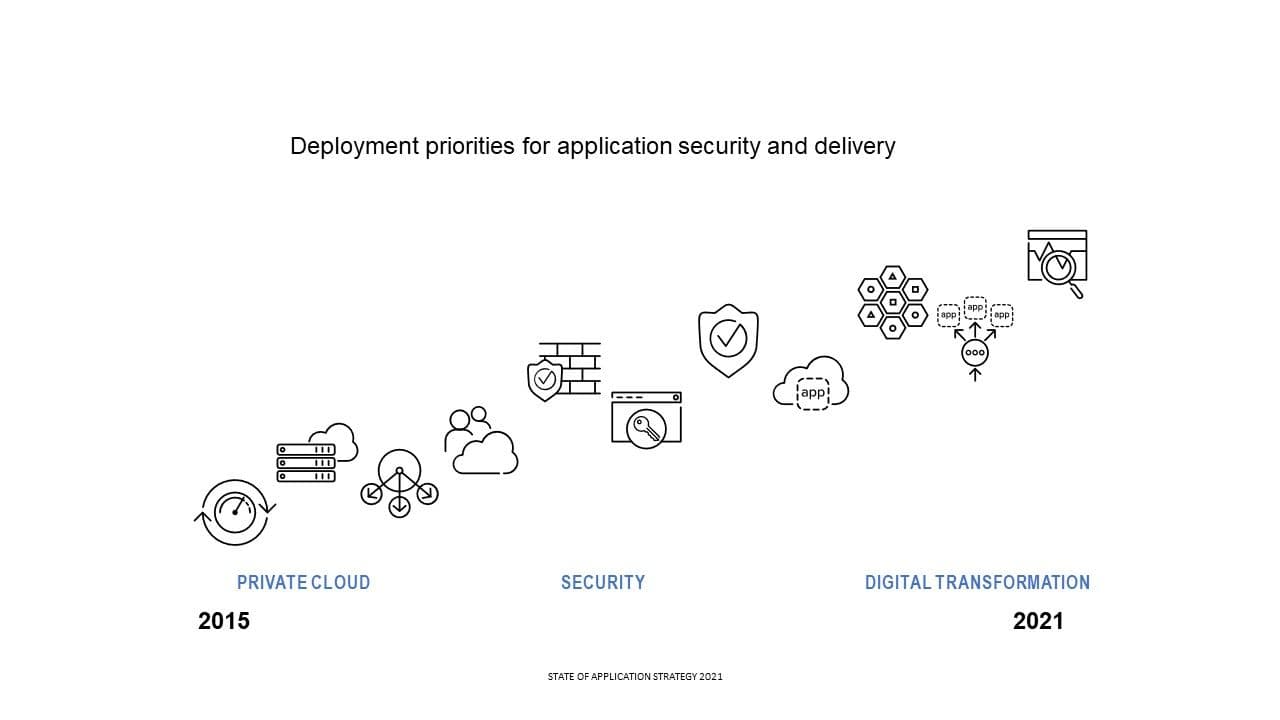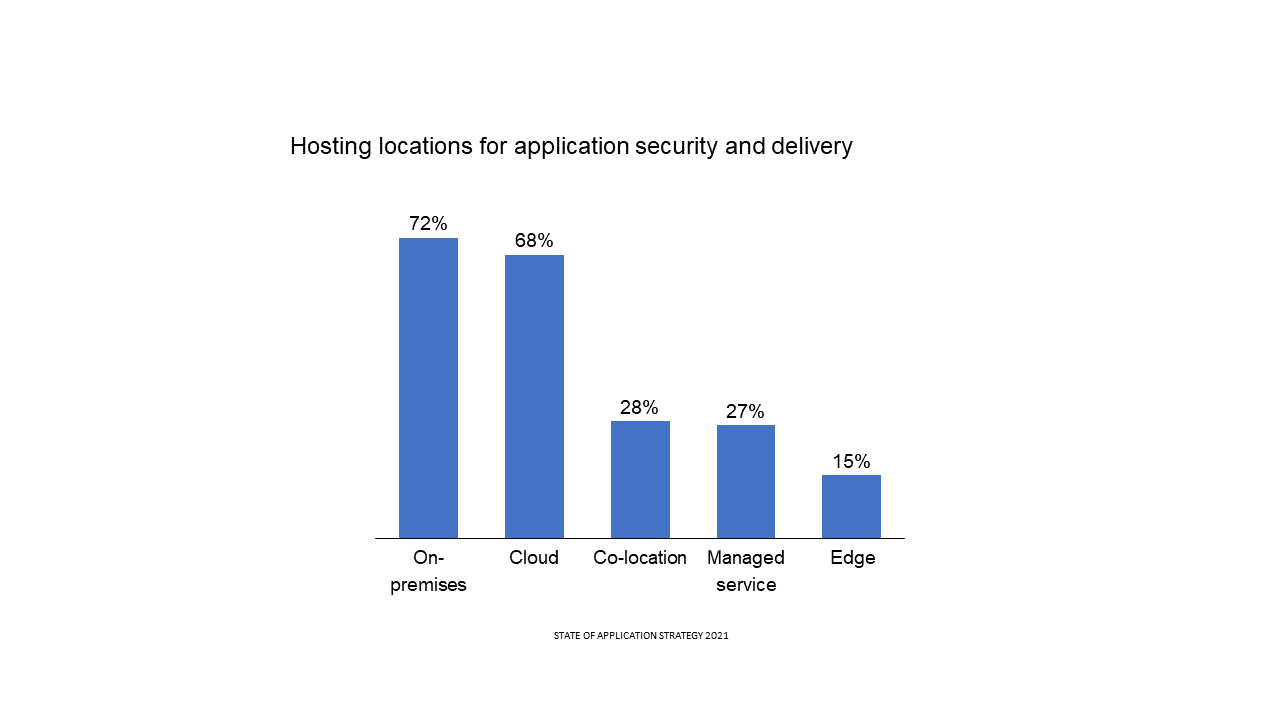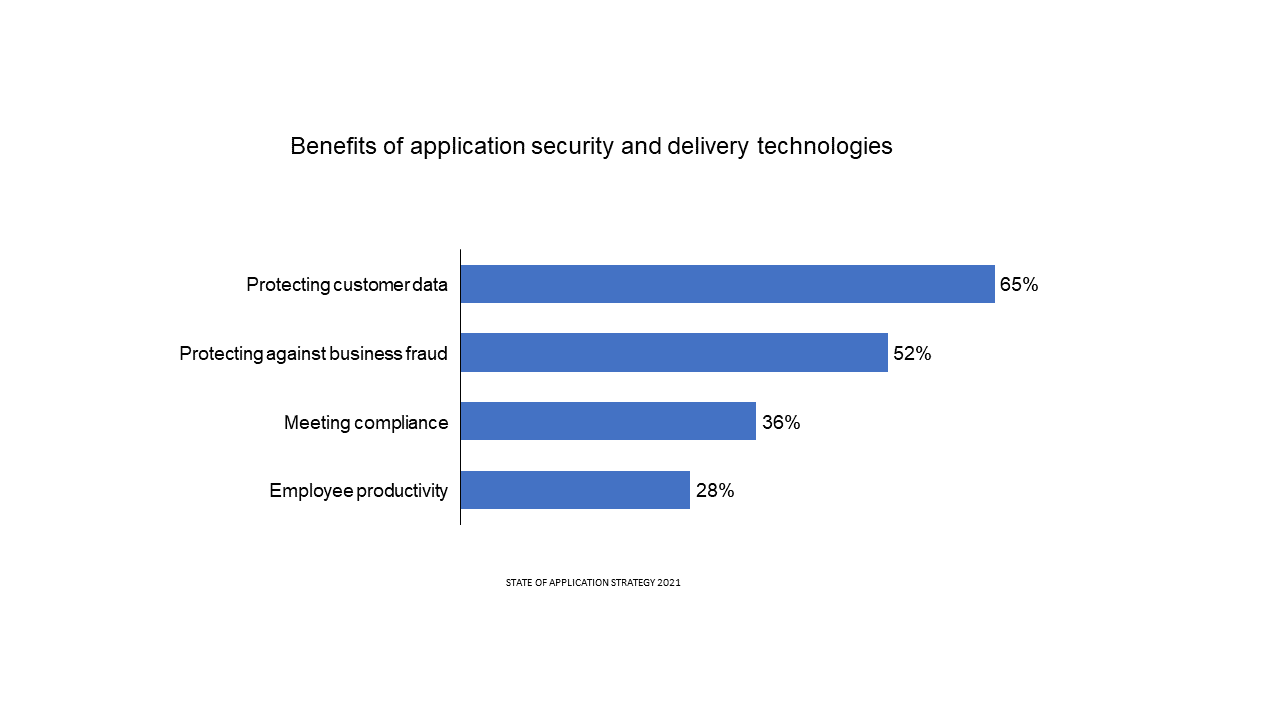Last year at this time we suspected that a long-term outcome from the COVID-19 crisis would be the acceleration of digital transformation initiatives. Indeed, our State of Application Strategy results confirmed that the percentage of organizations executing on digital transformation increased to 87% (up from 80% in 2020). As Lori MacVittie shared, organizations not only undertook new projects but also rapidly introduced digital experiences at scale, with 57% of organizations reporting they are in this phase of their journey, compared to 36% in 2020. Some of the more interesting projects include the expanded use of robotics to deal with COVID-19, such as sanitizing spaces, speeding up COVID-19 testing times, and even using robots to deliver food on college campuses. This last example no doubt just represents the early days of innovations for the tech-native Generation Z.
In the last seven years of our research, we have found that application security and delivery deployments mature and expand in lock-step with related digital transformation technology shifts such as application modernization, cloud, automation and, more recently, AI. Every year the top application security and delivery technologies planned for deployment indicate the strategic priorities of the coming year and how organizations are progressing through digital transformation. In 2015, the top strategic IT trend was private cloud, and organizations were starting to think about the growing challenges of delivering applications securely in a multi-cloud operational model. The top application services reflected this trend with DNSSEC, Global Server Load Balancing, and Identity eFderation topping the list. A couple of years later, the impact of security breaches reached the C-suite and respondents were prioritizing security technologies that protected the network, application, and user endpoints. DDoS, WAF, IPS/IDS, and Spam Mitigation led the list of planed technologies in 2017. In 2018, we started to see organizations preparing for digital transformation with SDN, API, and IoT Gateways emerging.
Fast forward to today and the planned deployments reveal the need to create secure, resilient multi-cloud application foundations. Digital transformation maturity requires agility and scale. Over three-quarters (77%) of respondents are using or planning to use containers. With a large ecosystem, many organizations see containers as a conduit to achieve agility and scale across multi-cloud deployments. The top three application service and delivery technologies planned for deployment are Service Mesh, Service Discovery, and SD WAN. Service Mesh and Service Discovery allow organizations to gain the agility benefits of microservices without sacrificing the needed policy and security to ensure production-ready resilient end user experiences.
The trend of distributed secure digital workspaces created through cloud applications is now mainstream. Not only is a hybrid work model here to stay for employees, so too is the need to stich applications and APIs across distributed data centers. SD WAN provides a cost-effective path to increase bandwidth quickly across globally distributed users and applications. Almost a third (31%) of respondents told us they are planning on rearchitecting the network and that SD WAN will be part of the end solution. The technologies planned for deployment this year confirm that digital transformation is creating a distributed and data-driven environment.
It is important to point out that application security and delivery technologies do not simply disappear. Global Server Load Balancing is just as important today as it was in 2015; deployments, application architectures, and the threat landscape mature as we build on our foundation and expand.

Application security and delivery technologies are hosted in all flavors of data centers from on-premises to the edge. This year, cloud began to reach parity with on-premises, and the edge emerged as an important location to increase performance, meet compliance requirements, and collect telemetry.

Security remains as important as ever. When rating the importance of application security and delivery technologies in achieving business outcomes, security-related outcomes were singled out as the most important. Protecting customer data is paramount, as is protecting the business against fraud. Employee productivity may be further down the list, but as organizations compete for scarce talent, we suspect that this outcome will rise in importance in the coming years. Employee productivity has a direct impact on the customer experience, and as work becomes home and home becomes work, employees will gravitate to those organizations who invest in skills, automation, and overall application performance.

Given the unprecedented demands on your time, Lori MacVittie and I are especially grateful to the thousands of you who told us about your IT strategies and deployments. The insights that we learned make us even more excited for next year when we suspect application security and delivery technologies that leverage AI to turn business telemetry into actionable insights through data analytics will be the cornerstone of organizations progressing in their digital transformation maturity.
For more, download your own copy of our 2021 State of Application Strategy report and make sure you read Keiichiro Nozaki insightful blog on modernization and edge trends in Asia Pacific. In addition, be on the lookout for additional insights on AI security and automation, and follow along on Twitter @F5.
About the Author

Related Blog Posts

Build a quantum-safe backbone for AI with F5 and NetApp
By deploying F5 and NetApp solutions, enterprises can meet the demands of AI workloads, while preparing for a quantum future.

F5 ADSP Partner Program streamlines adoption of F5 platform
The new F5 ADSP Partner Program creates a dynamic ecosystem that drives growth and success for our partners and customers.

Accelerate Kubernetes and AI workloads with F5 BIG-IP and AWS EKS
The F5 BIG-IP Next for Kubernetes software will soon be available in AWS Marketplace to accelerate managed Kubernetes performance on AWS EKS.
F5 NGINX Gateway Fabric is a certified solution for Red Hat OpenShift
F5 collaborates with Red Hat to deliver a solution that combines the high-performance app delivery of F5 NGINX with Red Hat OpenShift’s enterprise Kubernetes capabilities.
F5 Silverline Mitigates Record-Breaking DDoS Attacks
Malicious attacks are increasing in scale and complexity, threatening to overwhelm and breach the internal resources of businesses globally. Often, these attacks combine high-volume traffic with stealthy, low-and-slow, application-targeted attack techniques, powered by either automated botnets or human-driven tools.
Phishing Attacks Soar 220% During COVID-19 Peak as Cybercriminal Opportunism Intensifies
David Warburton, author of the F5 Labs 2020 Phishing and Fraud Report, describes how fraudsters are adapting to the pandemic and maps out the trends ahead in this video, with summary comments.
